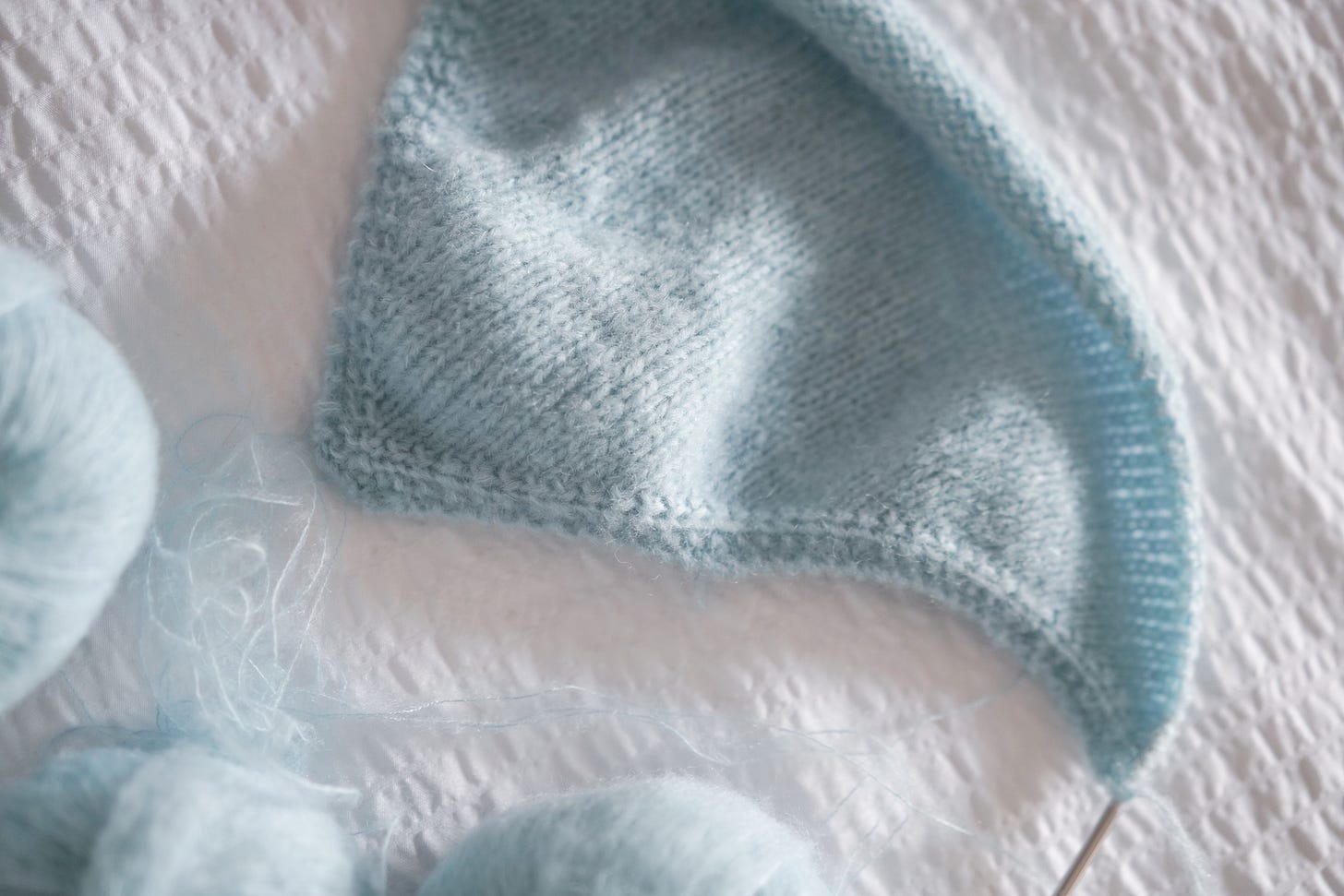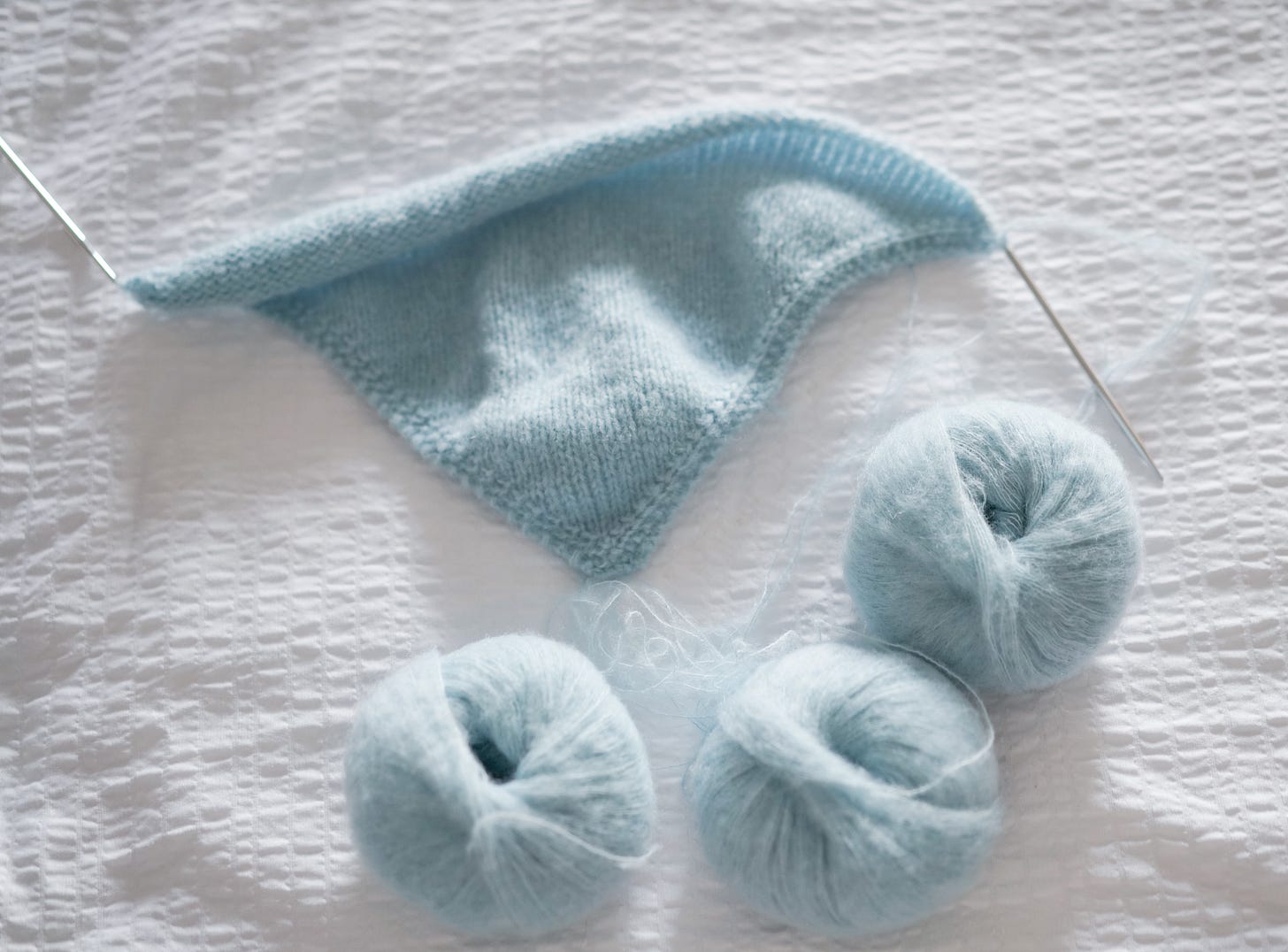Triangular Shawl Pattern
As someone who’s a little bit yankee, little bit y’all (I grew up between Houston, TX and Dorset, VT), I love a good bandana as well as some soft knitwear. While scouring Ravelry and beyond on the hunt for the perfect, simple pattern, I couldn’t quite find what I was looking for, so I decided to write my own and share it with you here. Think gigantic southwestern bandanas, cozy aprés neckwear, and Outlanderish shawls for a pop of color or extra transitional layer of warmth.
As I write to you today, my sample is not yet finished and I am trying a couple of different wools/gauges. I’ll update this post when finished! Warning: I’m a frog until I get it right kinda gal.
Yarn:
Any yarn of your choice (adjust to desired gauge). For this project, I chose three skeins of Pascuali’s Peruvian Mamanda Mohair, Silk, Merino, Yak blend in the color Horizon (415), knit together. For a proper shawl, one would need 6-9 depending on desired length.
These skeins grabbed my attention while I was visiting Monarch Knitting Shop in Monterey, CA and will match the recipient’s eyes beautifully! There are, however, many more affordable and accessible options. I originally was going to knit these together with a worsted weight wool, but due to the imbalance of the weights and thinking it was so beautiful on its own, I decided to pivot.
If three skeins of mohair is not your vibe, I also recommend 1 skein of Knitting for Olive’s Merino and 1 skein of Knitting for Olive’s Mohair knit together x 2 for a gorgeous combo.
For my second sample, I am using 4.5 mm circular needles with Air Drop Merino and Alpaca in color Sweet Orchid (41).
Needles:
3.75mm (US 5) needles, or adjust to achieve desired gauge. Because the pattern is flexible, feel free to adjust your needles per your yarn of choice.
Gauge:
Varies depending on your yarn choice, but the pattern is flexible and adaptable to any gauge.
Abbreviations:
K = knit
P = purl
Kfb = knit front and back (increase)
YO = yarn over (if preferred for eyelet effect)
St(s) = stitch(es)
RS = right side
WS = wrong side
TIP: If these terms seem unfamiliar to you, I recommend looking them up on YouTube! You have the option of either Kfb or YO for increasing your stitches— the one you choose will determine the aesthetic. For a more uniform stitch, choose kfb. If you would like to add eyelets in your work, select the YO approach.
I knit in the English way (this was just how I was taught) where it seems that Continental is more popular— so I will refer you to Youtube for demos. <3
If you need to switch skeins, I recommend doing so towards the edges for a cleaner finish when weaving in your ends.
Instructions:
Set-Up:
Cast on 5 stitches using your preferred method (e.g., long-tail cast on).
Row 1 (RS):
K1, P1, K1, P1, K1.
Row 2 (WS):
K1, P1, K1, P1, K1. (Repeat Row 1)
Row 3 (RS):
K1, P1, K1, P1, K1. (Repeat Row 1)
Row 4 (WS):
K1, P1, Kfb, P1, K1. (Increase on the third stitch with a Kfb)
Row 5 (RS):
K1, Purl all, K1. (Garter stitch border with purl stitches in the center)
Repeat the Following Rows:
Row 6 (RS):
K1, P1, Kfb, Knit to last 3 stitches, Kfb, P1, K1. (Increases at both edges and knit across the center)Row 7 (WS):
K1, Purl all, K1. (Garter stitch border)
Just Keep Knitting:
Repeat this process until the scarf or shawl nearly reaches your desired width and height. To elongate the width at a more accelerated rate, add more kfbs on either side of the border for each RS row.
Final Section:
Once you've reached your desired width, you will finish with Seed Stitch for the final three rows.
Row 1 (RS):
K1, P1, K1, P1, K1. (Seed stitch edge)Row 2 (WS):
K1, P1, K1, P1, K1. (Seed stitch edge)Row 3 (RS):
K1, P1, K1, P1, K1. (Seed stitch edge)
Bind Off:
Bind off loosely with K1, P1 pattern to match the border.
Finishing:
Weave in any loose ends using a yarn needle.
Gently block your shawl or kerchief to shape and smooth the fabric.
Optional:
If you prefer an eyelet look in your increases instead of the Kfb, you can substitute the Kfb with YO (yarn over) on the increase rows for a more open, lacy effect.
Enjoy your cozy knitwear!
This pattern can be easily adjusted by changing the yarn and needle size to create a larger or smaller scarf or shawl, depending on your preferences.






